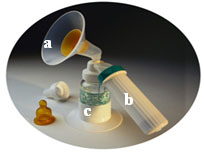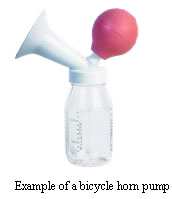Medical Devices
Breast Pump Basics
- What is a Breast Pump?
- What Does a Breast Pump Look Like?
- What Are the Types Breast Pumps?
- Are There Programs to Help Me Pay for a Breast Pump?
What is a Breast Pump?
Believe it or not, breast pumps are medical devices regulated by the FDA. Breast pumps are frequently used by breastfeeding women to extract (or express) their breast milk.
They can also be used to
- maintain or increase a woman’s milk supply
- feed multiple babies
- relieve engorged breasts and plugged milk ducts
- pull out flat or inverted nipples so a nursing baby can latch-on to its mother’s breast more easily
Many women find it convenient, or even necessary, to use a breast pump to express and store their breast milk once they have returned to work, are traveling, or are otherwise separated from their baby. Women are often delighted to learn that a breast pump can be used as a supplement to breastfeeding and that some pumps are designed to mimic the suckling of a nursing baby.
What Does a Breast Pump Look Like?
There are three main types of breast pumps: manual, battery-powered, and electric.

All breast pumps consist of a few basic parts:
- A cone-shaped cup, called a breast-shield, fits over the nipple and the dark, circular area surrounding the nipple (the
 areola).
areola). - A pump to create the gentle vacuum that expresses milk. The pump may be attached to the breast-shield or have plastic tubing to connect the pump to the breast-shield.
- A detachable milk collection container that fits below the breast-shield. The container is typically a disposable bag or a reusable bottle that can be used to store the milk, or attached to a rubber nipple and used for feeding a baby.
What Are the Types Breast Pumps?
A breast pump is typically held in place by hand; or by a nursing bra, a breast pumping bra or a band.
There are three basic types of breast pumps
- Manual pumps
- Battery-powered pumps
- Electric pumps
Breast pumps extract milk from the breasts by creating a vacuum around the nipple that pulls air into the breast-shield, and applies and releases suction. Each suction and release combination is called a cycle.
Manual Pumps
Many manual breast pumps use a system of two cylinders to create suction. Once the breast-shield is placed over the nipple and areola, a small cylinder-shaped tube is pumped in and out of a larger cylinder to create a vacuum that expresses milk and collects it in an attached container.
Some manual pumps have a handle or lever that is squeezed to create suction and express milk from the breast. The breast milk is then collected in an attached container.
Another type of manual pump is referred to as a bicycle horn pump and consists of a hollow rubber ball attached to a breast-shield. One of the earliest breast pump designs, the bicycle horn pump got its nickname from the old-fashioned bicycle horns it resembles.
To operate a bicycle horn pump, the breast-shield is placed over the nipple and the rubber ball is squeezed and released to create a vacuum that expresses milk. Some experts discourage use of the bicycle horn pump because they may be difficult to clean and dry.
Battery-Powered and Electric Pumps
A powered breast pump uses batteries, or a cord plugged into an electrical outlet to power a small motor that creates suction to extract milk from the breasts. One or more long plastic tubes connect the breast-shield to the motor. The motor has a control panel with a dial or switch to control suction.
Certain types of powered breast pumps can be adjusted to create different patterns of suction. Some manufacturers claim the adjustable suction allows the user to find a setting that closely mimics her nursing baby.
It is important that women who use a powered breast pump are prepared for emergency situations when electricity or extra batteries may not be available. Having extra supplies for pumping and a back-up method, such as a manual breast pump, may help a woman maintain her breast pumping schedule during an emergency.
FDA offers information on using medical devices in an emergency
Pumping Types
There are three different pumping types: single, double, and double-alternating.
| Pumping Type | How it Works | Types of Breast Pumps |
|---|---|---|
| Single | Extracts milk from one breast at a time. |
Most manual breast pumps are single pumps. Battery-powered pumps are commonly single pumps, perhaps because the single pumping action drains the battery at a slower rate than other pumping types. |
| Double |
Can be used to extract milk from both breasts at the same time. A separate breast-shield can be attached to each breast and stimulate both nipples at the same time. |
Some electric pumps are double pumps. Some women find that the dual suction decreases the amount of time it takes to empty their breasts. |
| Double-Alternating |
Can be used to extract milk from both breasts at the same time. Unlike the double pump, the double-alternating pump releases suction from one breast before applying suction to the other breast. |
Electric pumps are commonly double-alternating pumps. |
Are There Programs to Help Me Pay for a Breast Pump?
During the prenatal care period, contact your private health insurance company to determine what assistance is provided for breastfeeding and breast pumping equipment, including a lactation consultant or breastfeeding clinic for supportive care.
Some state health departments offer programs to help women purchase or rent a breast pump. For more information on the programs offered by your state, contact your state health department.
Low-income women may also be eligible to receive assistance with breastfeeding supplies, such as a breast pump, through the Special Supplemental Nutrition Program for Women, Infants, and Children (WIC) program. For more information, contact your state’s WIC representative.







